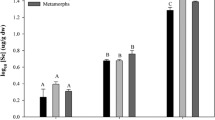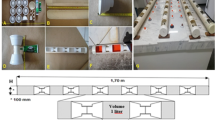Abstract
Several toxic effects of lead (Pb) have been documented in amphibians, but few studies have measured tissue levels of exposed specimens or examined toxicokinetics, availability of dietary versus waterborne sources, or route of entry. We modeled the toxicokinetics and examined the availability of dietary and waterborne Pb in both fed and food-deprived bullfrog (Rana catesbeiana) larvae. Uptake rates of Pb (1,000 μg Pb/L nominal exposure) were similar between fed and unfed larvae, but unfed larvae eliminated Pb slowly. Consequently, food-deprived larvae accumulated significantly more Pb compared to fed larvae. The intestinal tract contained > 90% of total body Pb in both fed and unfed larvae. Total body concentrations of Pb in fed larvae did not increase over 7 days although levels in food did increase. We concluded that food consumption influenced Pb accumulation through changes in elimination rates rather than in uptake rates. Pb appeared to enter the body of larvae through ingestion of contaminated water rather than food.
Similar content being viewed by others
Author information
Authors and Affiliations
Additional information
Received: 27 October 2000/Accepted: 4 April 2001
Rights and permissions
About this article
Cite this article
Rice, T., Oris, J. & Taylor, D. Toxicokinetics, Available Source, and Route of Entry of Lead in Fed and Food-Deprived Bullfrog (Rana catesbeiana) Larvae. Arch. Environ. Contam. Toxicol. 41, 450–457 (2001). https://doi.org/10.1007/s002440010271
Published:
Issue Date:
DOI: https://doi.org/10.1007/s002440010271




